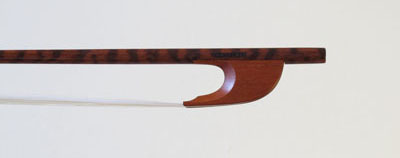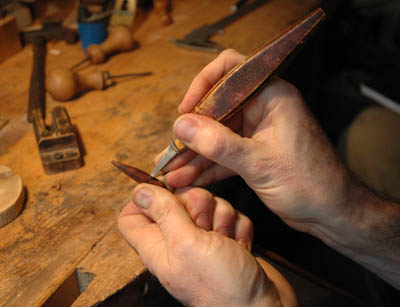Bowmaker David Hawthorne has been making bows for stringed instruments for over 30 years. This past September, he was awarded an MCC Traditional Arts Apprenticeship to pass on some of the knowledge he has acquired to Joel Pautz. A woodworker, Joel has studied violin making at the North Bennett Street School. Just before Christmas, I scheduled a visit see how their apprenticeship was progressing.
The 3rd-floor bowmaking workshop is smack in the center of Harvard Square, [just across the hall from Dewey Cheetham & Howe, the Car Talk guys!]. An outer office greets customers; beyond are two workshop spaces full of all sorts of bows in various stages of completion and numerous hand-made tools specific to the trade.
The focus of the apprenticeship is on a French style of bowmaking in the tradition of Dominique Peccatte. “Bowmaking,” David shares, as he gets settled at the workbench, “is a French-influenced pursuit because the French bowmakers were kind of the best.” David learned from a bowmaker who had studied in France, and then went to France himself to study bowmaking.

The bow Joel is currently working on is based on a model, the original of which is housed in the Powerhouse Museum in Austria. More simple than a modern bow, this baroque bow has a “clip-in” frog. Making a baroque style frog has the advantage of introducing the apprentice to many of the techniques of bowmaking, while modern bows demand skills and techniques beyond woodworking. For example, their screw-adjusted frogs require metalwork, jeweler’s techniques, and inlay.


David picks up one of two similar sticks from off the workbench. “We started with a stick. I saw this out at home on my bandsaw. You can see it’s kind of rough looking. And this one I’ve planed a certain amount . . . Joel has done that on a couple of his bows.”

What will follow are the many steps of planing the stick straight, carving the head, heating and bending the stick, and making and fitting the frog of the bow which holds one end of the horse hair.
David decides to demonstrate cutting a mortise, which is basically the hole where the horse hair will go. He speaks slowly, as he is working, “This is the drill we use, the French foret (click to view video) . . . So I’m going to make two holes and then I’m going to carve it out straight. And that’s just my depth stop, that piece of tape. That’s what we were discussing, how deep to make it. Obviously, you can’t make it too deep because it will make a hole through the bow. But you have to make it deep enough to accommodate the amount of hair you want to put in. So you kind of make it as deep as you dare.”


Making a bow demands superb woodworking skills and a keen eye, but how, I wonder, does one learn how to get the sound you want out of a stick of wood? Turns out the most obvious thing affecting the sound is the particular wood out of which each individual bow is made. David adds that the combination of violin and bow will always have to be matched. Being a violin player myself, I’ve noticed how the same instrument can sound so very different when played with a different bow. “Different bows will sound either brighter or darker or warmer or crisper, ” David says, which prompts me to ask, “Is that something you can set out to do?”
His answer is yes, but what he’s really after is great sound. “In general, a very flexible bow has a bigger, warmer sound. I’m interested in the best sound for a bow so I’m looking for a certain kind of flexibility, which can either be a function of the wood — is this wood strong? If it’s strong, did I maximize strength in the way I constructed it? Which is both a function of the thickness and the taper of the stick, and how you’ve curved it in the end. The camber.
What’s a good tone quality? Well, you don’t want it to sound nasal. You don’t want it to sound strident. You don’t want it to sound tood piercing. But, on the onther hand, you want it to have a certain openess of sound and you want it to have a certain beauty of sound.”
Joel is listening and watching and taking it all in.


